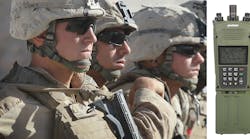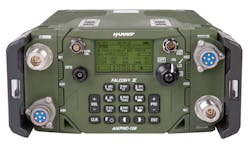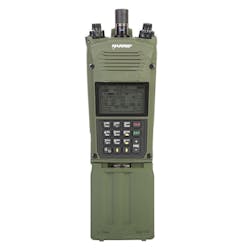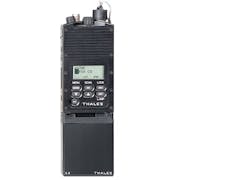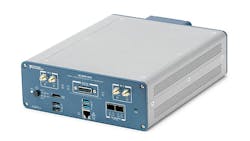Software-defined-radio (SDR) technology has been a part of efforts by the U.S. Army and other branches of the military to find a more powerful, more flexible tactical radio. For many years, the Army has relied on single-channel radio designs for tactical communications, which meant soldiers needed to carry separate radios when voice and data communications were performed simultaneously. But as the Army pursues two-channel Leader radios to replace aging single-channel Rifleman radios, it’s also counting on the continuing development of SDR technology for added flexibility in its radios.
The SDR concept is simple: Replace as much of the traditional RF/microwave analog radio front-end architecture with digital, programmable components and software so that a single radio can quickly be switched to handle multiple channels and frequency bands. The design concept supports military efforts for reduced size, weight, and power (SWaP), and the use of software programmability conceivably makes an SDR difficult to jam or intercept signal-wide by an adversary. SDRs also have the programmable flexibility to function as nodes or repeaters as part of a secure battlefield communications network.
Still, for a technology that has been in the works for more than three decades, how well is it helping military systems designers to meet their goals for portable, secure, and reliable battlefield communications?
From Analog to Mixed-Signal
Some analog components in a superheterodyne radio are essential for communications, such as receive and transmit antennas, low-noise amplifiers (LNAs) to help decipher low-level signals at the receiver, filters for screening unwanted signals, and power amplifiers (PAs) to boost signals from the radio for transmission. The basic design approach of an SDR system replaces as many analog components from an analog radio front end, such as frequency mixers and local oscillators (LOs), as possible. They are replaced with mixed-signal components, e.g., analog-to-digital converters (ADCs) and digital-to-analog converters (DACs), and digital components, e.g., digital signal processors (DSPs) and field-programmable gate arrays (FPGAs), that can be programmed to modify radio performance as needed.
Programmability provides the flexibility to adjust, for example, channel bandwidths in the field without having to make changes to the printed circuit board (PCB) and component modules inside a radio’s enclosure. SDRs can be built around general-purpose processors (GPPs), DSPs, or FPGAs, with the three types of digital processors providing low, medium, and high data rates, respectively, with low, medium, and high-power efficiency, respectively. The software part of the design, known as a software communications architecture (SCA), makes an SDR “future-proof” by allowing an operator to update the radio in the field without making hardware modifications.
SDR technology is probably most closely associated with tactical radios and the U.S. Army’s Joint Tactical Radio System (JTRS) program. The JTRS program created an upgrade path for aging military radios such as the Army’s Rifleman that, although extremely reliable, was a single-channel design with limited capabilities.
The JTRS program looked to technologies such as SDR and multichannel radios to provide the flexibility and performance needed in the field, for instance, to secure networking and simultaneous voice and data communications. Having such capabilities in a single package could greatly reduce the amount of equipment that a soldier needed to carry into the field. With SDR technology, the radios could be repurposed as needed in terms of channel bandwidths, modulation formats, and transmit power.
Tactical Radio Evolution
The JTRS program gave rise to what were considered portable “manpack” radios with SDR and SCA programmability. They are durable and flexible, but hardly considered “handheld” units. The FALCON IV AN/PRC-158 from L3Harris is an example of a JTRS manpack radio based on SDR technology (Fig. 1).
The rugged AN/PRC-158 manpack covers a total frequency range of 30 to 2,500 MHz. It can be programmed to operate with a wide range of modulation formats, including narrowband AM/FM, VHF/UHF, and SINCGARS waveforms, MIL-STD-188 UHF satcom waveforms, and soldier-radio-waveform (SRW) formats. It has an embedded Global Positioning System (GPS) receiver for automatic position location reporting and is certified to Type 1 “top secret” levels by the National Security Agency (NSA) for secure data and voice communications.
However, the AN/PRC-158 radio does not represent the most lightweight and portable tactical radio configuration. To meet modern military requirements for SWaP, the same company developed an AN/PRC-163 multichannel handheld tactical radio based on SDR technology (Fig. 2). Measuring just 6 × 3 × 2 in. (15.24 × 7.62 × 5.08 cm) and weighing a mere 2.75 lbs. (1.13 kg) with its rechargeable battery, the handheld SDR covers a total frequency range of 30 to 2600 MHz. The two channels provide NSA-certified secure communications on overlapping (such as satcom, VHF, and UHF) bands, with programmable channel spacing from 5 kHz to 10 MHz on channel 1 and from 5 kHz to 40 MHz on channel 2.
The compact AN/PRC-163 tactical radio design is more in league with U.S. Army goals for newer Leader radios that can deliver two-channel secure radio performance in a handheld package. It has attracted major contract bids from the U.S. Army because of its capabilities and SWaP compatibility. Similarly, the AN/PRC-148 two-channel tactical radio from Thales provides a great deal of flexibility and power while meeting SWaP goals (Fig. 3). It’s also based on SDR technology and capable of multiple channel and modulation formats from 30 to 512 MHz while operating with the security of Type 1 NSA encryption.
Even traditional high-frequency (HF) military short-wave radios have benefited from SDR technology as in systems like the R&S M3SR Series4100 HF radios from Rohde & Schwarz. These rugged but large SDRs target shipboard and fixed-installation applications. With frequency-hopping capabilities, they can provide secure voice and data communications even over crowded HF channels.
The M3SR Series4100 HF radios operate at transmit frequencies from 1.5 to 30 MHz and receive frequencies from 10 kHz to 30 MHz. They can achieve long-range data links with 24-kHz channel bandwidths and include embedded hardware support for wideband 48-kHz channels in line with MIL-STD-188-110C Appendix D requirements.
For those involved in SDR development, whether for military, commercial, or industrial applications, USRP SDRs from National Instruments are part of prototyping kits. The hardware modules (Fig. 4) combine host-based processors, radio front ends, and reconfigurable FPGAs with full API support for the company’s LabView Communications System Design Suite of design software.
The USRP SDRs can be configured with as many as 2 × 2 transceiver channels or 4 receiver channels for prototyping experimentation. And they are able to be programmed for as much as 160-MHz instantaneous bandwidth across a frequency range of 10 MHz to 6 GHz. The software enables design and simulation of SDR systems with wide real-time bandwidths, such as for spectral monitoring and direction-finding (DF) applications.
Saving Software Time
An important aspect of any SDR is how much it can change functionality, such as power levels, frequency channels, and modulation formats, by means of software upgrades. The software-guided modifications should be efficient and effective and not require difficult-to-manage upgrade routines. The U.S. Army, for example, has investigated ways to speed the time to initialize and load software into a battalion’s worth of SDRs for a mission (Fig. 5).
The Army also seeks to turn the exercise of programming SDRs into a general-purpose task rather than something to be done only by specialists. To achieve new, faster programming software, the Army's Program Executive Office for Command, Control and Communications-Tactical (PEO C3T) approached its Unified Network Operations Middle Tier Acquisition (UNO MTA) team for the software development.
The prototype SDR programming software consists of several parts. The Integrated Planner creates configuration files for SDRs to function as part of tactical networks. This planner portion of the prototype PEO C3T software is designed to integrate or replace existing network planners. The Network Operations Management System (NOMS) helps manage the network and supports classified, non-classified, and coalition network enclaves with common functionality. The Initialization Tool Suite (ITS) makes it possible for soldiers to manage and modify their network initialization data products for end-to-end network connectivity and interoperability of a wide range of tactical and COTS data products.
The Codex portion of the PEO C3T software suite is a database with open application programming interfaces (APIs) to allow for interoperability among different applications on a tactical communications network. Atom is a simplified radio planner for creating new waveform choices and layouts, potentially replacing legacy network management capability. The Black Sails portion of the software suite works with Atom to configure the SDRs according to the requirements of the network plan, generating configuration files and loading the radios.
The suite of software tools is helping to analyze and understand the in-field networking needs for SDRs and how to program them more quickly to meet those needs. The UNO MTA team working on the software is hoping to make SDRs more usable by Army troops and to reduce the number of tools needed by soldiers to keep their radios up-to-date.
As these software tools are being developed, they are also being applied to different radio types, including Leader radios, to test the software’s functionality as part of efforts to create an integrated tactical network (ITN). Having an ITN will make it possible to link military and commercial networks for secure communications with military and coalition partners. An ITN would include fixed terrestrial networks, mobile base stations, and satellite communications (satcom) terminals.
The next step in the evolution of SDRs will be their inclusion in cognitive radio systems, which are “smart radio systems” that apply artificial intelligence (AI) to achieve optimum communications links and thwart an adversary’s efforts at jamming signals. Cognitive radios apply techniques such as spectrum sensing and channel sounding to detect interference and unwanted signals as well as locate available frequency spectrum for secure radio communications. Data from spectral measurements are used to find open channels and then program the SDR accordingly.
